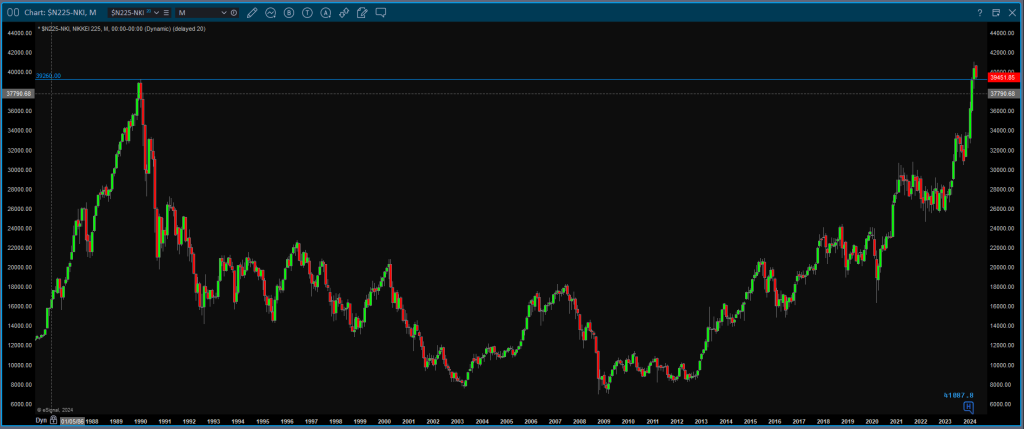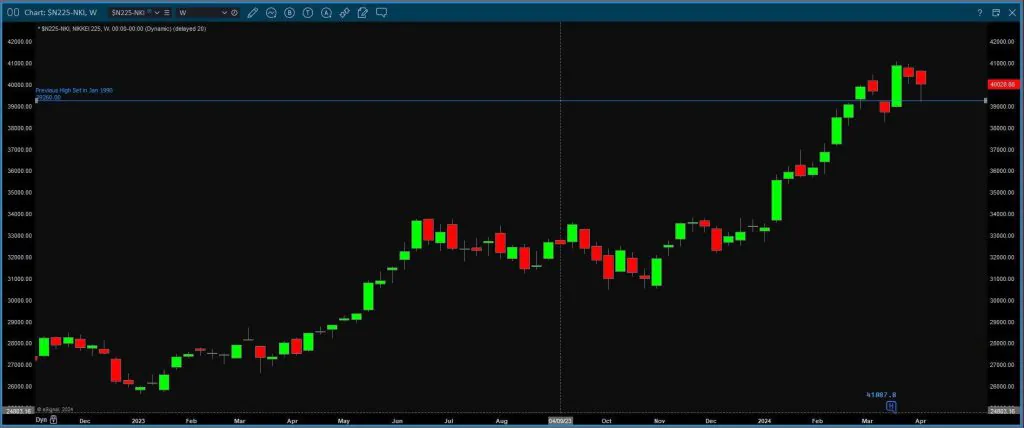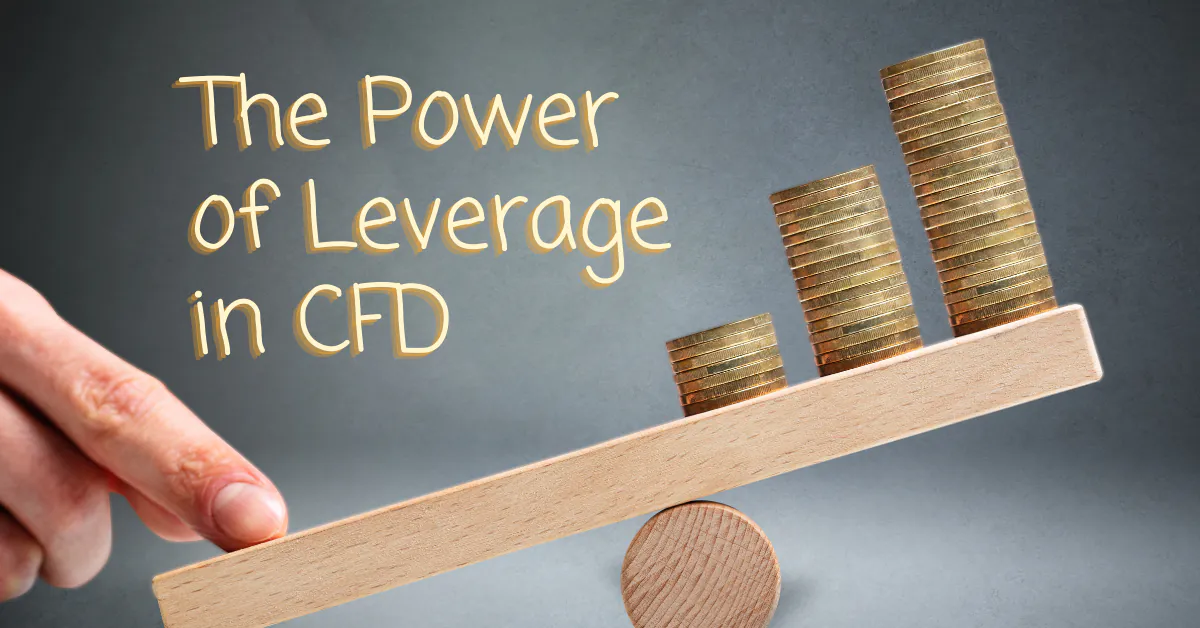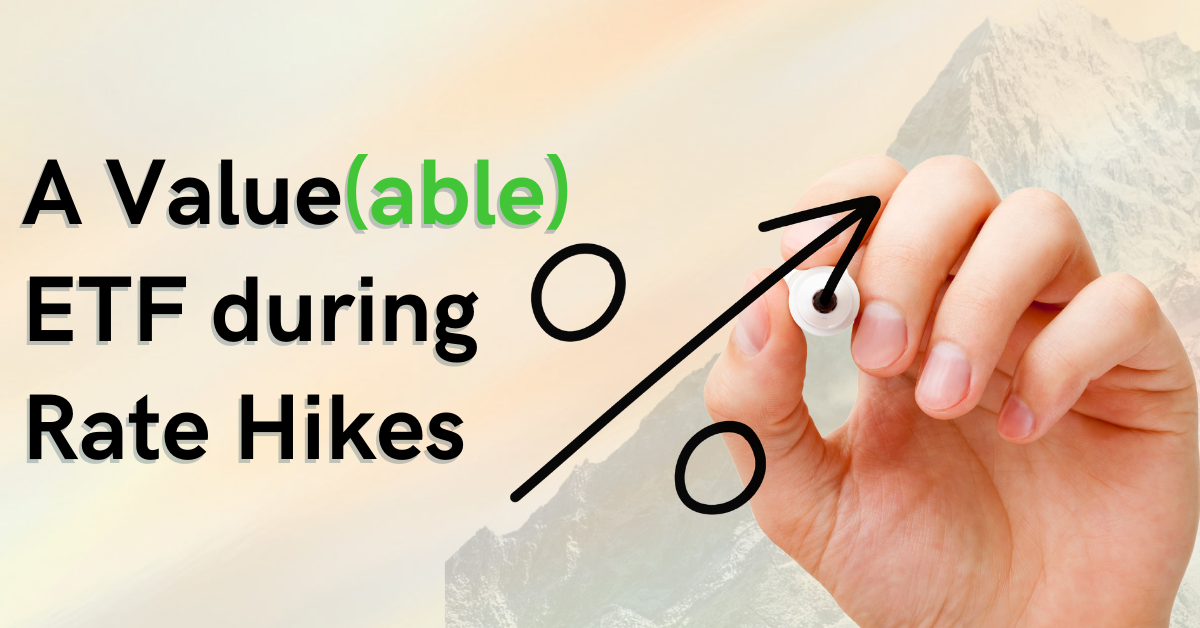Japan's Economic Resurgence – Unveiling the Tailwinds Behind Nikkei 225’s Record Leap

Kah Chee Liew, Manager, Dealing
Kah Chee graduated from Nanyang Technological University with a Bachelor’s Degree in Accounting. With more than 10 years of experience as a full time, professional investor and trader specialising in the Hong Kong and US markets, he employs fundamental and technical analyses with experience in a multitude of financial instruments

Source: eSignal, Intercontinental Exchange, Inc.
In the heart of Japan’s economic landscape, the Nikkei 225 Index stands tall like a beacon of resilience and dynamism, capturing global attention with its 20% surge in 2024Q1, to an astonishing record high of 41087.75 on 22 Mar 2024 (vs S&P’s 10% rally). Significantly breaching the previous pre-dot.com bubble historical high of 39,260 in 1990, 34 years ago, this remarkable rally is the result of a complex interplay of forces spanning macroeconomics, politics, corporate dynamics, and the currency markets.
In this article, we will:
- uncover the forces behind Japanese market’s record surge
- delve into Japan’s economic performance, challenges and future prospects
- learn which Phillip CFD products can help you ride the Japanese market’s volatility

Source: eSignal, Intercontinental Exchange, Inc.
Unveiling the forces behind Nikkei 225 Index’s rally
- Technological Innovation and Corporate Leadership
At the core of Japan’s resurgence lies its relentless pursuit of corporate excellence and technological innovation including artificial intelligence, robotics, and renewable energy, to catalyse productivity gains for global competitiveness. With a focus on efficiency and adaptability, corporations within the Nikkei 225 Index have fortified their positions, attracting investors bullish on Japan’s ability to thrive in the digital age. Supported by a 15% surge in R&D expenditure[1], companies within the Nikkei 225 Index such as Toyota and Sony, propelled stock prices to unprecedented heights, fuelling optimism among investors.
- Government Stimulus and Economic Reforms
The Japanese government’s unwavering commitment to economic stimulus and structural reforms has provided a robust foundation for the ascent of the Nikkei 225 Index. In 2024, fiscal measures aimed at infrastructure development (resulting in a 20% surge in infrastructure spending[2]), healthcare expansion, and green initiatives have injected vitality into the economy. Furthermore, regulatory reforms to promote corporate governance, enhance shareholder rights, and facilitate foreign investment have garnered acclaim, positioning Japan as an attractive destination for capital inflows. These initiatives, coupled with fiscal prudence, ignited optimism and drove stock market gains.
- Stable Political Environment and Policy Continuity
With a political stability index at an all-time high[3], Japan’s commitment to long-term growth has attracted foreign investors. The policy continuity of economic policies across administrations has reinforced investor confidence, propelling the Nikkei 225 Index to new heights amidst global uncertainties.
- Strong Corporate Performance and Profitability
Robust corporate performance emerged as a driving force behind the Nikkei 225 Index’s record surge. In 2024, with a focus on operational efficiency, cost optimisation, and strategic diversification, Japanese firms have reaped the rewards of prudent management practices, enticing investors seeking growth opportunities. Companies within the index have demonstrated resilience and agility in navigating challenges, further buoyed by robust domestic demand and resilient export markets. The companies posted strong corporate earnings which surpassed market expectations, at a 25%[4] year-on-year growth rate.
- Japanese Yen and Export Competitiveness
Over the past year, the Japanese Yen’s weakness accelerated significantly due to several factors, primarily the divergence in monetary policies between the Bank of Japan (BOJ) and other major central banks such as the Federal Reserve and the European Central Bank. The BOJ’s commitment to maintaining an accommodative monetary stance, including low-to-negative interest rates and asset purchases, has put downward pressure on the Yen. According to data from the BOJ and Nikkei Asia, the Yen depreciated by approximately 15% against the US dollar and the Euro during this period, contributing to Japan’s export competitiveness and corporate earnings. This weakening Yen has significantly benefited Japanese exporters, especially those in the technology and automotive sectors, and boosted corporate profitability for export-oriented companies such as Toyota and Sony. Consequently, the Nikkei 225 stock index experienced a notable uptrend, reaching multi-month highs.
- Regional Integration and Trade Agreements
Japan’s active pursuit of regional integration and trade agreements has enhanced its economic resilience and market access. In 2024, ratification of the Comprehensive and Progressive Agreement for Trans-Pacific Partnership (CPTPP) and the Japan-EU Economic Partnership Agreement (JEEPA) expanded Japan’s trade horizons, which opened new avenues for growth and investment. By deepening economic ties with key partners in the Asia-Pacific region and beyond, Japan further fortified its position in global commerce, fuelling optimism among investors in the Nikkei 225 Index.
- Demographic Revitalisation and Labor Market Reforms
Japan’s pursuit of demographic revitalisation and labour market reforms has also injected vitality into its economy, driving the Nikkei 225 Index to new heights. In 2024, initiatives aimed at promoting workforce participation, further empowering women, and attracting skilled immigrants have mitigated demographic headwinds, unleashed latent potential and fostered economic dynamism. With a burgeoning pool of talent and an ethos of innovation, Japan has positioned itself as a beacon of demographic resilience, enticing investors with the promise of sustained growth and prosperity.
This represents nearly a fivefold rise in consumer spending on e-commerce platforms!
It is widely understood that goods purchased online are manufactured in and often exported from Asian countries such as China. Consequently, businesses engaged in international trading are required to hold multiple currencies as exporters typically prefer to make transactions in US dollar (USD) or their local currency.
Therefore, businesses have flocked to the forex markets to hedge against currency fluctuations, hoping to save thousands, if not millions of dollars.
Japan’s Economic Landscape and Future Trajectory
In the chronicles of economic history, 2024 emerges as a pivotal chapter for Japan, characterised by a confluence of challenges and opportunities that delineate the nation’s trajectory. As we dissect the intricate web of economic metrics, demographic shifts, and policy dilemmas, a multifaceted portrayal of Japan’s economic landscape comes into focus, offering glimpses into its future course.

Inflation and Deflation Dynamics
Central to Japan’s economic narrative in 2024 is the perennial spectre of deflationary pressures, a lingering legacy of decades-long stagnation. Despite concerted efforts by policymakers to reignite inflation and achieve the elusive 2% target, Japan’s core consumer price index (CPI) remained flat[5] in the first quarter of 2024, which underscores the persistent deflationary pressures and structural impediments weighing on the economy. The struggle against subdued price dynamics persists, constraining consumer spending and investment sentiment despite monetary stimulus measures. This economic backdrop underscores the urgent need for sustainable inflation and renewed vitality.

Demographic Realities and Aging Population
At the heart of Japan’s economic conundrum lies its intensifying demographic challenges, with declining birth rates exacerbated by a rapidly ageing population, which surpassed 35% in 2024[6]. The nation grapples with the implications of this transformation, including labour shortages amidst fiscal pressures and rising healthcare costs. Policymakers face the daunting task of crafting innovative solutions to mitigate these effects and bolster long-term growth prospects.
General Wages and Income Inequality
Wage stagnation and income inequality further complicate Japan’s economic landscape. Despite a tight labour market, wage growth remains tepid with general wages growing modestly at 1.5%[7]. This reflects broader trends of stagnation amidst economic resilience, thereby constraining household purchasing power and consumption, and exacerbating social tensions. Addressing these disparities becomes a central policy challenge, emphasising the need for inclusive economic development.
Economic Growth and Structural Reforms
In the pursuit of sustainable growth, Japan’s policymakers are embracing structural reforms and innovation. Amidst global uncertainties, the nation seeks to unleash its latent potential through productivity-led growth initiatives. Bold reforms, from digital transformation to investment in human capital, aim to revitalise the economy and enhance competitiveness.
Conclusion
Looking ahead, Japan’s economic trajectory in 2024 and beyond hinges on navigating these uncertainties:
- GDP growth is projected to moderate to 2.2%[2] by the end of 2024
- Global challenges such as supply chain disruptions and geopolitical tensions exist
- Inflation / deflation dynamics, demographic shifts, and wage stagnation also persist
- Proactive policy measures, strategic investments, and structural reforms emerge as pillars of resilience in shaping Japan’s economic destiny.
Japanese Market’s 34-year Inflexion Point – Gain Exposure with Japan 225 Index CFD
As one of Phillip CFD’s most popular indices in 2024, Japan 225 Index JPY100 CFD tracks the performance of the Nikkei 225 Index, which represents Japan’s top 225 publicly traded companies. This index is especially suitable for traders who want exposure to the booming Japanese market but do not have the time to perform analysis for stock-picking.
Benefits of Trading the Japan 225 Index JPY100 CFD:
- Flexibility: CFDs offer flexibility in trading strategies, allowing traders to go long (buy) or short (sell) positions based on their market outlook. As one of the most volatile markets in the world, year-to-date, this versatility enables traders to profit from both rising and falling markets under various market conditions.
- Leverage: Our Japan 225 Index CFD allows traders to enjoy 20X leverage on their capital; hence, enabling them to control a larger position size with a small amount of capital. As the Nikkei 225 Index reaches multi-decade highs, this feature appeals to traders to open long or short positions with a mere 5% capital outlay to amplify their potential returns. Do note that losses from leveraged products would be amplified in the same magnitude if the market were to move by the same level against your entry.
- Accessibility and Diversification: Japan 225 Index JPY100 CFD provides accessibility to the performance of Japan’s top 225 publicly traded companies without the need for traders to directly purchase individual stocks. This convenience allows them to gain exposure to a diversified portfolio with ease.
- Cost Efficiency: Trading Japan 225 Index JPY100 CFD involves lower transaction costs compared to traditional stock trading. With narrower spreads and lower (or zero) commission fees, traders can maximise their returns by minimising expenses associated with trading.
- Risk Management Tools: For investors and longer-term traders who already have open positions in Japanese equities, Japan 225 Index JPY100 CFD can be deployed as a hedging tool if they believe that a short-term market pullback against their positions is imminent.
Other Japan-Related CFD Products
Traders and investors can also explore opportunities to ride the volatility in the Japanese market with other similar CFD products which they are familiar with, namely:
- Japan equities CFD
- Tokyo Index JPY1000 CFD
- FX CFD for exposure to USD/JPY amongst other JPY pairs
Volatility Presents Opportunities
- The Japanese equities market is one of the best performing markets, with the Nikkei 225 gaining 20% year-to-date (at close of 29 Mar 2024). Which Japanese stocks stand to benefit at these crossroads?
- The Nikkei 225 Index broke a 34-year high; will the rally persist? Or is a pullback imminent?
- The Japanese Yen is at multi-year lows against the USD and a basket of currencies, where is it heading next?
Would you want to wait another 30 years for an opportunity to profit from the market volatility and liquidity of the most developed Asian Economy?
Promotions

Get a S$30 Cash credits Welcome Bonus when you open a POEMS CFD MT5 account and fund S$2000 into the account!
*T&Cs Apply.
For more information, click here.
How to get started with POEMS

Trade Smarter and Faster
With our newly launched POEMS Mobile 3 Trading App
Explore a myriad of useful features including TradingView chartings to conduct technical analysis with over 100 technical indicators available!
Take this opportunity to expand your trading portfolio with our wide range of products including Stocks, CFDs, ETFs, Unit Trusts and more across 15 global exchanges available for you anytime and anywhere to elevate you as a better trader using our POEMS Mobile 3 App!
For enquiries, please email us at cfd@phillip.com.sg. If you are interested in active discussions, you can also join our Telegram community here.
More Articles
The Power of Leverage in CFD
What is leverage? Read our article to find out more about the different uses of leverage through the use of Contract for Differences (CFDs) for both traders and long-term investors.
Why You Should Consider Dividend Investing
Have you tried dividend investing? Learn more about why you should consider dividend investing!
A Value(able) ETF During Rate Hikes
Interested in buying valuable ETFs? Read on our article to find out more!
Disclaimer
This material is provided to you for general information only and does not constitute a recommendation, an offer or solicitation to buy or sell the investment product mentioned. It does not have any regard to your specific investment objectives, financial situation or any of your particular needs. Accordingly, no warranty whatsoever is given and not liability whatsoever is accepted for any loss arising whether directly or indirectly as a result of your acting based on this information.
Investments are subject to investment risks. The risk of loss in leveraged trading can be substantial. You may sustain losses in excess of your initial funds and may be called upon to deposit additional margin funds at short notice. If the required funds are not provided within the prescribed time, your positions may be liquidated. The resulting deficits in your account are subject to penalty charges. The value of investments denominated in foreign currencies may diminish or increase due to changes in the rates of exchange. You should also be aware of the commissions and finance costs involved in trading leveraged products. This product may not be suitable for clients whose investment objective is preservation of capital and/or whose risk tolerance is low. Clients are advised to understand the nature and risks involved in margin trading.
You may wish to obtain advice from a qualified financial adviser, pursuant to a separate engagement, before making a commitment to purchase any of the investment products mentioned herein. In the event that you choose not to obtain advice from a qualified financial adviser, you should assess and consider whether the investment product is suitable for you before proceeding to invest and we do not offer any advice in this regard unless mandated to do so by way of a separate engagement. You are advised to read the trading account Terms & Conditions and Risk Disclosure Statement (available online at www.poems.com.sg) before trading in this product.
Any CFD offered is not approved or endorsed by the issuer or originator of the underlying securities and the issuer or originator is not privy to the CFD contract. This advertisement has not been reviewed by the Monetary Authority of Singapore (MAS).










